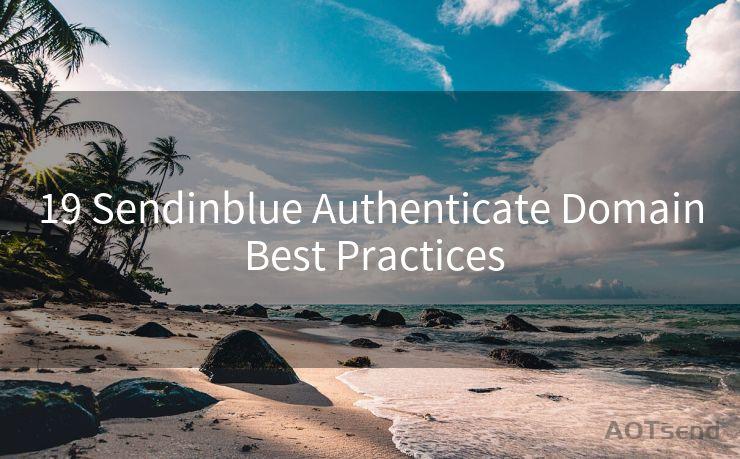19 Sendinblue Authenticate Domain Best Practices




Email marketing remains a powerful tool for businesses to reach their customers. However, ensuring that your emails actually reach your subscribers' inboxes can be challenging. One key factor in improving email deliverability is authenticating your sending domain. In this article, we'll explore the 19 best practices for authenticating your domain with Sendinblue to maximize the chances of your emails being delivered successfully.
1. Understanding Domain Authentication
Domain authentication is a crucial step in email marketing. It involves verifying that you are the rightful owner of the domain you're sending emails from. This process helps email providers recognize your messages as legitimate, reducing the chances of them being marked as spam.
2. Choosing the Right Authentication Methods
There are several methods for authenticating your domain, including DKIM (DomainKeys Identified Mail), SPF (Sender Policy Framework), and DMARC (Domain-based Message Authentication, Reporting, and Conformance). It's essential to implement all three for maximum effectiveness.
3. Setting Up DKIM
DKIM uses a private key to sign your outgoing emails. When an email provider receives a message, it uses the corresponding public key to verify the signature. Setting up DKIM involves generating a key pair and adding the public key to your DNS records.
4. Configuring SPF
SPF allows domain owners to specify which IP addresses are authorized to send emails from their domain. By adding an SPF record to your DNS, you're telling email providers which servers are legitimate senders.
5. Implementing DMARC
DMARC builds on DKIM and SPF by providing a policy for how email providers should handle unauthenticated messages. It also enables senders to receive reports on the authentication status of their emails.
6. Keeping Records Up to Date
Once you've set up your authentication methods, it's crucial to keep your DNS records up to date. Any changes to your sending infrastructure should be reflected in your DNS settings.
7. Monitoring and Troubleshooting
Regularly monitor your authentication status and troubleshoot any issues that arise. Tools like MX Toolbox can help you check your DKIM, SPF, and DMARC records.

8. Avoiding Common Pitfalls
Be aware of common mistakes, such as typos in DNS records or forgetting to update your records when changing email providers.
9. Working with Your Email Service Provider
Many email service providers, including Sendinblue, offer tools and support to help you with domain authentication. Take advantage of these resources to ensure a smooth setup.
10. Testing Your Setup
After setting up your authentication methods, send test emails to various providers to ensure they're being delivered correctly.
11. Improving Email Engagement
Authenticating your domain not only improves deliverability but also enhances your reputation as a sender. This can lead to higher engagement rates and better overall email performance.
12. Staying Compliant with Regulations
In some regions, email authentication is a legal requirement. Staying compliant with these regulations can help avoid potential legal issues.
13. Protecting Your Brand
By authenticating your domain, you're protecting your brand from being impersonated by spammers or phishers.
14. Enhancing Customer Trust
Authenticated emails are more likely to be trusted by recipients, leading to higher open and click-through rates.
15. Preparing for the Future
As email authentication becomes more widespread, it's essential to stay ahead of the curve and ensure your emails are properly authenticated.
🔔🔔🔔
【AOTsend Email API】:AOTsend is a Managed Email Service for sending transactional emails. Support Email Types: reminders, authentication, confirmations, notifications, verification codes, invoices, password resets, account activations, billing statements, two-factor authentication (2FA), and one-time passwords (OTP) emails, etc. $0.28 per 1000 Emails. 99% Delivery, 98% Inbox Rate.
You might be interested in:
Why did we start the AOTsend project, Brand Story?
What is a Managed Email API, How it Works?
Best 25+ Email Marketing Platforms (Authority,Keywords&Traffic Comparison)
Best 24+ Email Marketing Service (Price, Pros&Cons Comparison)
Email APIs vs SMTP: How they Works, Any Difference?
16. Measuring Success
Use analytics tools to measure the impact of domain authentication on your email marketing campaigns. Look for improvements in deliverability, open rates, and click-through rates.
17. Adapting Your Strategy
As your email marketing strategy evolves, be sure to adapt your authentication practices to match your changing needs.
18. Educating Your Team
Make sure your team understands the importance of email authentication and how it fits into your overall marketing strategy.
19. Staying Up to Date with Best Practices
Email authentication is an evolving field. Stay up to date with the latest best practices to ensure your emails continue to reach your subscribers' inboxes.
By following these 19 best practices for authenticating your domain with Sendinblue, you can significantly improve your email deliverability and enhance your overall email marketing performance. Take the time to set up and maintain your authentication methods correctly, and you'll reap the rewards of a more effective and trusted email marketing campaign.




Scan the QR code to access on your mobile device.
Copyright notice: This article is published by AotSend. Reproduction requires attribution.
Article Link:https://www.mailwot.com/p4657.html



